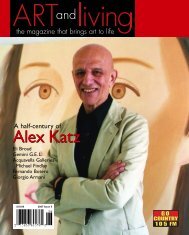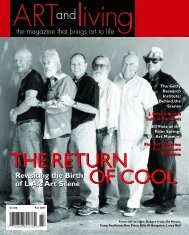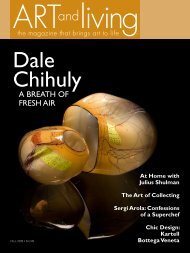Ed Ruscha Ed Ruscha Ed Ruscha - Art and Living
Ed Ruscha Ed Ruscha Ed Ruscha - Art and Living
Ed Ruscha Ed Ruscha Ed Ruscha - Art and Living
- No tags were found...
You also want an ePaper? Increase the reach of your titles
YUMPU automatically turns print PDFs into web optimized ePapers that Google loves.
artist profileBeyond Goya’s GhostsThis fall, filmmaker Milos Forman brings Goya’sGhosts to the big screen, taking the extraordinaryhistorical <strong>and</strong> personal circumstances surroundingthe life of vaunted Spanish master Francisco José deGoya y Lucientes <strong>and</strong> imagining the kind of eventsthat could have shaped the artist, his work <strong>and</strong> hischanging outlook on the world in which he foundhimself. <strong>Art</strong> <strong>and</strong> <strong>Living</strong>’s Andy Johnson took a strollthrough the galleries of Madrid’s Museo del Prado—which house one of the world’s most extensivecollections of the artist’s works—in order to sortout the real Goya: his life, his passions <strong>and</strong>, most ofall, his art. Here’s what he discovered. By Andy JohnsonDuring his lifetime, Francisco José deGoya y Lucientes (born in a smallAragonese village, Fuendetodos in1746) went from being one of eighteenth <strong>and</strong> nineteenthcentury Spain’s most popular portraitists toa widely-revered progenitor of modern art.Despite his position as a commissioned portraitistfor the wealthy <strong>and</strong> the noble during his career—both before <strong>and</strong> after being officially named aspainter to the king Carlos IV in 1786—flashes ofGoya’s individuality <strong>and</strong> his tendency to break withthe conventions of the artistic strictures of his timecan be seen again <strong>and</strong> again in the broad spread ofhis oeuvre showing permanently throughout theMuseo del Prado. The artist’s darker work, producedafter he reached middle age, would becomea key inspiration for later movements likeExpressionism <strong>and</strong> Surrealism.Of Goya’s life, one thing is certain: he lived intrying times. In late eighteenth century Spain, the fanaticism of the SpanishInquisition was subsuming the forward-thinking ideas of the Enlightenment thathad been so fuelling intellectual life throughout Europe at the time; hate, suspicionFrancisco José de Goya y Lucientes, Self Portrait, 1815 (age69). Oil on canvas. Madrid, Museo del Prado.<strong>and</strong> ignominy within the more conservative sections of the elite began to grow.A direct indication of these harrowing times comes from Goya’s famousetching, ¡Lo que puede un sastre!, 1797-98 (What a Tailor Can Do!) from hisCaprichos series, displayed on the second floor of the Prado.What appears to bea monk towers over a young woman on her knees. However, on closer examination,the towering oppressor is simply a tree draped with a habit. The imagesuggests the essential emptiness of the ecclesiastical tyranny at this time but alsohints at the power of its outward symbolism alone. The message seems to be:dress up anything as a powerful figure <strong>and</strong> the innocent will kneel before it.In this etching, we can see where writer Jean-Claude Carrière may havefound inspiration for the plot of Goya’s Ghosts, which follows the events surroundingthe reinstated Inquisition’s persecution of Goya’s young muse Ines (played byNatalie Portman) for heresy despite Goya’s (Stellan Skarsgård) pleas to friend <strong>and</strong>Inquisition spearheader Brother Lorenzo (played by Javier Bardem).Goya is believed to have suffered something ofa nervous breakdown between 1792 <strong>and</strong> 1793, whena mental <strong>and</strong> physical deterioration nearly killed him<strong>and</strong> caused him to go deaf. Another debilitating illnessstruck him in 1819, bringing him close to death for asecond time. The title <strong>and</strong> the disturbing content ofanother of Goya’s etchings from this tortured periodalso on show on the second floor of the Prado, 1797-98’s El sueño de razon produce monstruos (The Sleep ofReason Produces Monsters), suggests the forces plaguingthe artist’s beleaguered mind.Salas 36-38 on the first floor of the Prado arehome to Goya’s Pinturas Negras (Black Paintings),transferred to canvas from the walls of the artist’sQuinta del Sordo (“The country house of the deafman”) residence near Madrid, where he livedbetween 1820 <strong>and</strong> 1823. In these works, Goyabroke from almost every Rococo <strong>and</strong> Neoclassicalinfluence when he painted over l<strong>and</strong>scapes—originallyintended as pleasant <strong>and</strong> pastoral scenes to decorate the walls of hishome—with images that draw from mythology <strong>and</strong> legend <strong>and</strong> reflect thedepravity, violence <strong>and</strong> war that surrounded him.66 2006 Issue 4






